“So let me get this straight. You want me to pull the electric pump out so you can put in a manual pump?”
My husband and I nodded at the man who had come to remove our broken electric pump. He scratched the back of his head, a funny sort of half-smile creasing his cheeks. “You know, most folks are goin’ the other way.”
Watch The Video
The idea of hand pumping water in the 21st century must seem a little backward at first glance, but we (like many other homesteaders, farmers, and preppers), knew that having a system that allowed us to fetch water with nothing other than two arms and some time could have serious benefits.
Manual water pumps should be a consideration for anyone who has a well run by an electric pump, and should even be considered by those on city water. Though water towers create water pressure with gravity, the only way water gets up into the tower in the first place is by being mechanically pumped.
And when you realize that all it takes is a long power outage to cut off your water supply, I bet most of you would like to be able to access it no matter what the circumstances. Manual water pumps are one way to build a little resilience into your homestead, whatever the size. Read on to learn more about the basics of what it takes to use a little hand power to draw your own water.
Manual Hand Pump Options
The world has changed quite a bit since the Laura Ingalls days of drawing water with a bucket on a pulley. If you decide to make the switch to manually-pumped water, you may find that that there are two companies that really dominate your searches.
Both Simple Pump and Bison Pump are well-established (pardon the pun) hand-operated pump businesses with a solid customer base and lots of experience. Though there are other companies that offer manual pumps, both Bison Pump and Simple Pump are made in the USA and are relatively easy to incorporate into an existing well.
How Hand Pumps Work
Though the design has been modernized, all wells pretty much function the same way. Drill a hole deep enough into the earth that you reach an aquifer, and then find some way to bring water to the surface. A manual pump really isn’t that much different than an electric save the very obvious fact that your arms, not the grid, are drawing the water.
When you pump the handle up and down, you are moving a rod and piston within a long PVC pipe that has been lowered below your water line. Every time you pull the handle down, water is raised up, and every time you allow the handle to go up, the pump is lowered into the water, loading itself for the next push.
For those curious, Simple Pump has a good explanation of each part and piece of their system. The nice thing about both of these modern pump designs is that there is no priming needed and very little maintenance. As in, you’ll need to give the entire system a once-over probably every five years or so.
All-Weather Manual Pumps
Manual pumps should work in all seasons, as long as they have something called a “weep hole” installed. This simple hack is just a hole drilled into the PVC pipe below frost level. After you’re done pumping, water will slowly leak out until it reaches equilibrium, ensuring that the pipe itself will never freeze solid.
As someone who has personally pumped water on a 1-degree morning, I can guarantee that this makes it possible to use a hand pump in temperatures well below freezing. To be clear, my pump is operating in Ozark winters, not Alaskan winters. If you’re in an area with deep permafrost, make sure you do your research before installation!
How to Incorporate a Manual Pump With a Modern Home
When you install a manual pump, it’s up to you how off-grid you want it to be. You may choose to have it be your main source of water, or you can use it as a backup. It may give you peace of mind to know that it’s completely possible to install a hand pump side-by-side with an electric pump which gives you both convenience and water security. If you do decide to have a manual pump only as a backup, however, you’ll need to make a point to pump some water every other day or so, just to make sure the system is in good working order.
If the idea of lugging buckets for your daily water use is not for you, it is also possible to use a manual pump to pressurize the water inside a house. Not every manual pump is capable of inside use, so be sure to do your research! Using this system, you can manually pump water from your well, through a hose, and into a pressure tank.
Related Post: Rainwater Harvesting: The Basics And Why You Should Start Today
The tank can then allow water to flow from faucets and into toilets so much of your house functions as “normal.” Pumping water into the pressure tank will become just another one of the daily chores.
Hand Pump Costs
It is hard to give an exact figure on how much a hand pump will cost you. The overall cost depends on how deep your well is and what model you want.
The deeper the well, the more expensive it will be, as you will need a larger number of sucker rod and pipe segments. Additionally, if you have no well drilled already, the price will rise exponentially. On our homestead, we opted for using the well that had already been dug, and added the manual pump to the system.
Our well was fairly deep, so the final price for our entire system was a little over $2,000. Keep in mind that this doesn’t include the price of getting the original well pulled out. Also, we saved money by choosing to do the installation ourselves.
In your minds, this may small price to pay for having consistent, weather-proof access to your water. Additionally, wit allows you handle and understand every piece of the unit as you do oyur installation. It can certainly give you confidence that you could fix the pump yourselves if trouble struck.
Hand Pump Water Depth
So, how deep can you hand pump water? The answer to this question is entirely dependent on the type of pump you decide to install. The Simple Pump I use is capable of working from a depth of 325 feet static water level.
Before you get any pump installed on your property, take the time to find out all of your personal well’s specifications so you can make the best choice. Finding our well’s information was only possible by having a service come out and pull the old well for us, so you may have to do quite a bit of work if the information is not on record.
Is Hand Pump Water Safe to Drink?
This is a complicated question, because it is totally dependent on your personal well, how deep it was dug, what’s in the surrounding area, and what method is used to transport the water. Once upon a far-off time, well water could probably be drunk directly without fear of contamination, but now you need to be a little less trusting and a lot more proactive when it comes to managing your water.
In general, the deeper the well has been dug, the safer the water, but I would still recommend having your personal well water tested once you have access to it. Personal wells are not monitored and protected by agencies like the EPA, so the responsibility falls into your hands. Thankfully, there are relatively cheap kits you can order to test the water yourself, and there are plenty of services you can find online who can give you a “report card” of what’s in your water.
On our homestead, all of the water that we use for drinking and cooking goes through a Berkey Water Filtration system first. These filtering systems get my highest recommendations, and if you are looking for a way to make any water safe, I think you could find no better option.
I’m not sponsored by them or paid by them — I have just depended on our Berkey system for many years, and the faithful thing has worked without a hitch. The filtration system is expensive, admittedly, but when it comes to something as vital as water, many of us are more than willing to forgo some nights out to eat and department store clothes in favor of having decades of safe water.
Tips From a Manual-Pump Homestead
If you are doing research on manual pumps to see if you could switch your home or small farm over to hand-pumped water, then you’re just as passionate about self-reliance as we are. As such, I have some tips and tales for those of you who are willing to forgo modernity in favor of some sloshy, hand-pumped goodness.
First off, nothing will make you more aware of your water use than pumping it yourself. In order to depend on a manual pump, you must change your mindset when it comes to water use.
Related Post: Living Off-Grid: What It’s Actually Like
The average American uses an astounding 80-100 gallons of water a day. That wasteful, thoughtless manner of living is just not possible with a manual pump.
I see that as a good thing.
Do you think it’s possible to get through a whole day using only 50 gallons of water? 20? 10? I’ll let you in on a secret–a human can comfortably make it through a day with only 5 gallons of water for personal use. I’ll leave it to you to figure out how to make it work.
But what about laundry day, you may ask? Or watering animals? Here’s my tip — there’s no need to have your hand pump be the sole source of water for the homestead. If you pair your manual pump with a rain catchment system, then you will have more water than you know what to do with. Use rainwater to water animals, the garden, and wash laundry. The you can reserve the work of hand-pumping water for drinking, cooking, and dishes.
Related Post: How to Make a DIY Rain Barrel
Another thing that will benefit the manual pump user are some really good buckets. Food-grade 5-gallon buckets can be used for pretty much anything water-related on your homestead. You can order them new, or check out your local Craigslist to breathe some new use into old, food-industry buckets.
You may think that the effort of pumping water may be too much for you, but like anything, you can get used to it. The first week we used our manual pump for daily use, I admit I got pretty tired. But now that I have years of pumping and bucket-hauling under my belt, I’m much stronger, more grateful, and much, much less wasteful. Best of all, no power outage can take my water from me again.
Do any of you hand pump your own water? Or, if you’re considering installing a hand pump, what questions drove you to make the switch? Let me know in the comments below!


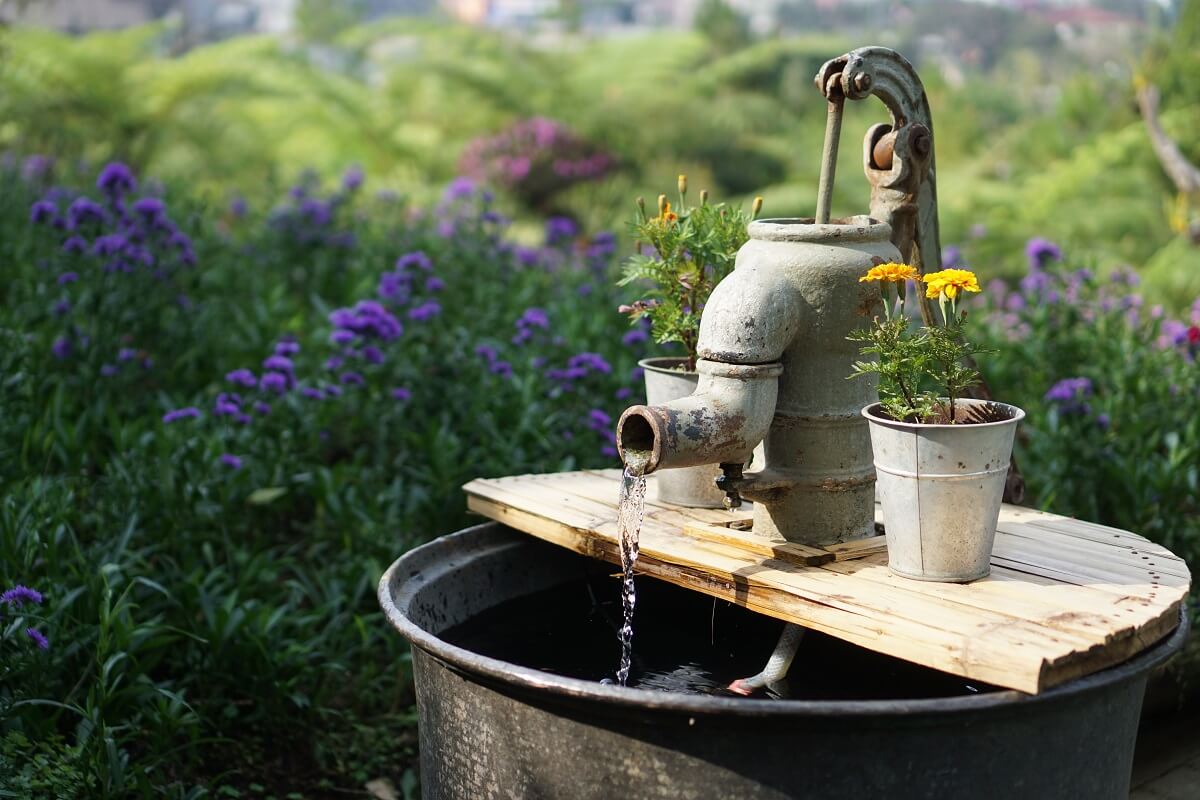
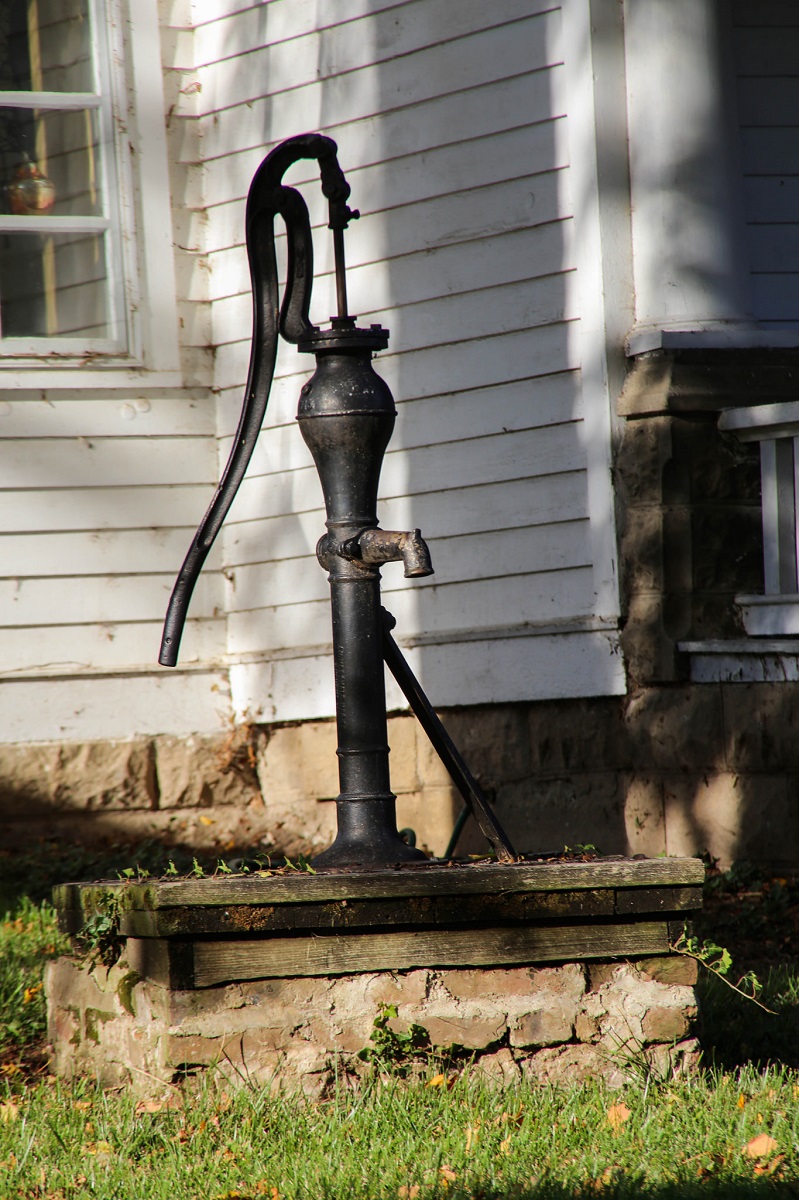





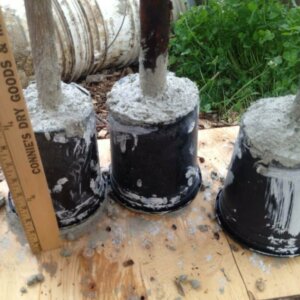
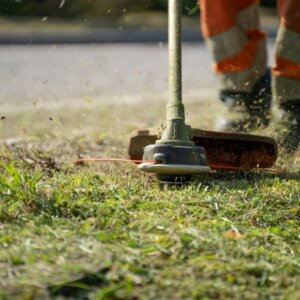

















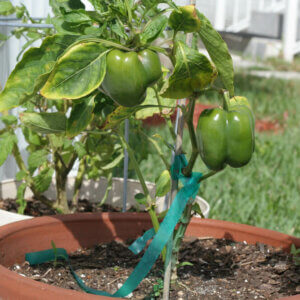















We had a hand pump on the farm in Wheatfield Indian. No elec, no phone: builds muscles, about 20 feet deep in glacial sand and silt. Best water I ever tasted.
Thanks for your comment, Ray! I’m so glad that someone else out there knows the joy…because it IS a joy…of doing thing the “hard” way. A hard-working life is a good life. Hope you have a lovely spring!
I’m moving off grid to a cabin in Montana. Rain catchment will be the primary source of water. My design is to pump water from the 2,000 gallon ferrocement catch tank up the hill behind the cabin to two connected 2,500 gallon ferrocement tanks to create a gravity feed system. I’m researching a simple type pump that I can power with a windmill. The property is in escrow and the water system in on the drawing table. I’ll start building the water system sometime this summer (2019).
Rain Catchment is the way to go! We are working on getting our systems in place so that it can, one day, become our primary source of water. The Simple Pump system that we’re using for well water isn’t the best for windmill power, but the website recommends that you can hook the windmill to a generator, and then use that generator to power the Simple Pump. http://www.simplepump.com/support/questions/windmills/ Hope you find a good plan that works for you!
Could any of these pumps (or another solution) be used to draw water from a lake?
Hey, Marx. The pumps I mentioned in the article (Bison Pump and Simple Pump, specifically) are intended for a drilled well. When it comes to drawing water from a lake, there are a separate set of considerations to keep in mind–such as battling gravity, the legalities (if you don’t personally own the lake) and dealing with sediment. I don’t have experience with using our personal surface water for anything beyond an occasional bucket drawn from the pond, so to help you in your search, I recommend checking out Country and Cottage Water Systems by Max Burns (http://www.worddust.ca/pages/ccws.html). There’s a section on surface water that may be useful to you. It also depends on what you intend to use the water for–watering a garden ( https://cabinlife.com/articles/article/how-to-pump-lake-water-for-an-outdoor-faucet) will require a lot less hassle than turning lake water into household water.
I hope that helps!
My wife and I bought raw property in Central Texas. It had a well but it is 700′ to the water level, so we chose not to install a pump on it. After building our homestead house I built a rainwater harvesting system with 5,000 gal of storage. It has met our water needs for the last 12 years with absolutely no problems. I wish we could have a hand pump but the depth of the well excludes that possibility.
Rainwater harvesting is, by far, my favorite method of getting the water we need! It sounds like you have a fantastic system for your homestead. I can’t really imagine how long it would take to get the flow going with hand-pumping 700 feet up…sheesh!
Love hearing stories like yours. Thanks for your comment!
Sounds like an amazing water catching system. Can you provide any more details? I’m looking at high desert, mountain living and I’ll likely have to catch water too.
I hope the pump I need exists.
My spring and cistern (6 ft deep) are 400 feet from my house and about 20 feet lower.
Want to hand pump from the house and hoping that is possible.
Any help appreciated.
Alan
How interesting that you talk about how it is not necessary to have a hand pump be the sole source of water for the household. I am starting a new business this summer. I will find a good pump puller company in my area for this as well actually.
With our culture unraveling, this 80 year old grandma wonders if we are well into the “Last Days”. I want to prepare my holdings to sustain life for whom ever follows me, possibly some of my younger relatives. I want a water source that is reliable and does not require electricity. Bison looks good to me.
When I was a child, we had only hand pumped water. I know we can live with that. I was 10 when electricity came to our area. No matter what will happen in our near future at least we can have water to drink, wash in, cook with, etc.
Photo/Attachment:
I have a picture of a hand pump in a house I’m buying but not sure make and model. Realtor said it was stuck any thoughts? Can’t get to the house till after closing
I have a jet pump in my basement with 2 pvc lines going out about 30′ to the well, then down the well about 115′ deep to a foot valve. Is there a manual pump system available that can be attached to the existing piping inside the basement?
Watch Engineer775 on YouTube
I’m needing a manual water pump to pump my collected rain water through a drinking water filtration system. The filters I’m looking at rquire 20PSI minimum pressure to pump water through the filters. What kind of manual pump might be favorable for my purpose?
The dual water system comment is a well stated reminder of an age old solution. My generational family home in the Ozarks used a duel system up until 1985. Drinking and cooking water going to a special kitchen faucet came from an 80′ well via an isolated system. All other water (wash, toilet, bathing, outdoor use) came from a surface ground water source (year round creek). In 1985 we drilled a deep well, 500 feet, and converted the whole house over to single source. I am living here full-time now and decided to pull the abandoned electric pump from the shallow well and set it up as a back-up manual well.
Photo/Attachment:
I am helping a friend look into replacing their old hand pump in their cabin. We’ve been having trouble with it holding prime the last few years even with new leathers etc. The cabin in not used in the winter and is in northern New England, so freezing is obviously an issue as far as preventing broken pipes etc. The well is a hand dig well that is approx. 20ft deep. There is a pipe (somewhere at an unknown depth) running underground from the well under the cabin and up through the floor to the current pump. I am guessing the distance from the well to the cabin is maybe 100ft but not sure. Anyone have any ideas on what brand and model will work to replace this pump? Cabin is used for 2-3 months a year and we can’t afford anything crazy, but we need a reliable water pump. The handle has to be at a right angle to the spout too as there isn’t room to use pump otherwise.
Hi, we’re considering installing a Bison hand pump to move water from our 80′ well into a pressure tank. I’m having a difficult time finding any videos from someone that uses a system like this. I’m wondering how much time and effort it takes to fill a tank (on the surface by the well) with 40 gallons of water and whether that alone pressurizes the tank (e.g., do you need to add air too?). Any feedback from direct experience would be greatly appreciated!